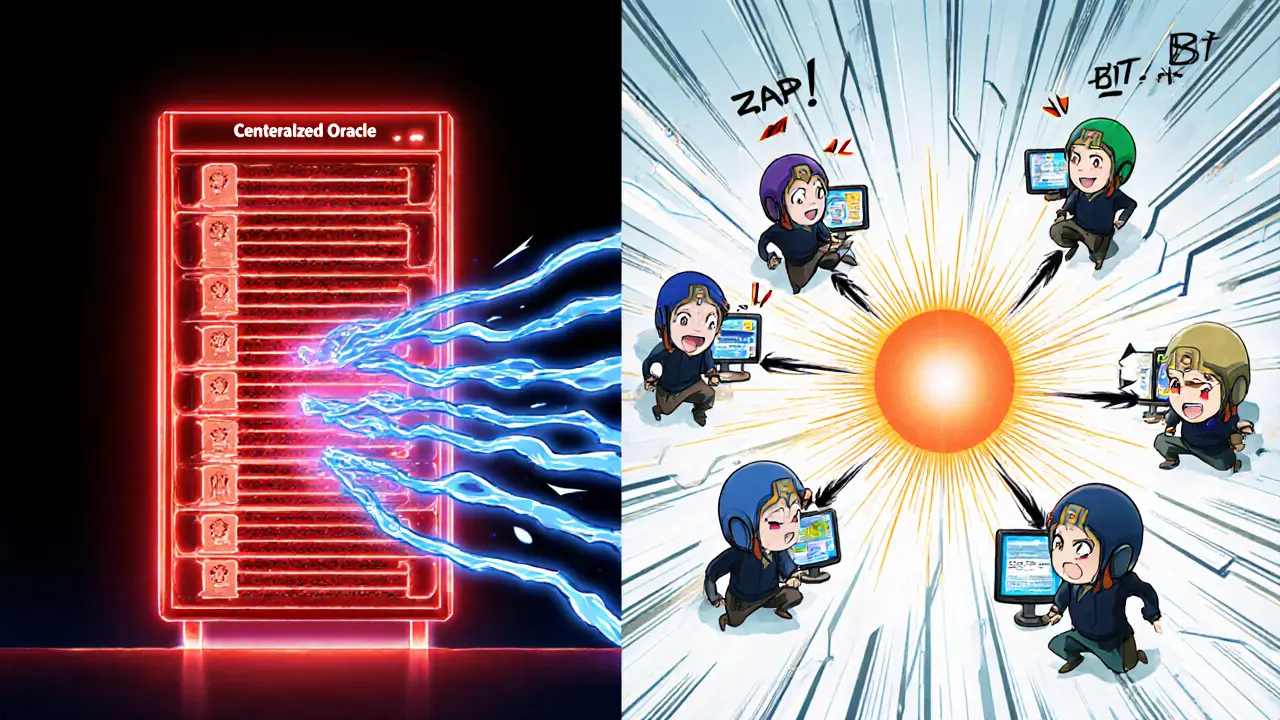Decentralized vs Centralized Oracles: Pros, Cons, and How to Choose

Oracle Selection Calculator
Oracle Selection Assessment
Answer these questions to determine the best oracle type for your project.
When a smart contract needs to react to the real world-like a price feed, weather report, or sports score-it relies on an blockchain oracle is a middleware component that fetches external data and delivers it to a blockchain in a trust‑minimal way. The big debate today revolves around two architectural extremes: centralized oracles are oracles run by a single operator or data source versus decentralized oracle networks (DONs), which distribute data collection and verification across many independent nodes. Understanding their trade‑offs helps you pick the right tool for your dApp, DeFi protocol, or any on‑chain logic that needs off‑chain inputs.
Quick Takeaways
- Centralized oracles are fast and easy to integrate but create a single point of failure.
- Decentralized oracles add security and censorship resistance at the cost of higher latency and complexity.
- Choose centralized solutions for low‑risk, non‑financial data; opt for decentralized networks for high‑value DeFi or mission‑critical contracts.
- Layered decentralization-data source, node operator, and network-greatly reduces manipulation risk.
- Future oracle designs aim to blend the speed of centralized systems with the trust guarantees of decentralization.
How Oracles Work: Push vs Pull
Oracles bridge the on‑chain/off‑chain gap using two basic interaction models. In a push model, the oracle continuously streams data (e.g., price updates every 30 seconds) to the blockchain, ensuring the latest value is always on‑chain. This model suits high‑frequency trading but consumes more gas and bandwidth. In a pull model, a smart contract explicitly requests data when needed, paying only for the specific query. Pull reduces cost but adds request latency. Both models can be implemented by centralized or decentralized providers; the key difference lies in who controls the data source and verification process.
Centralized Oracles: Simplicity Meets Vulnerability
A centralized oracle is an oracle operated by a single entity that fetches data from one source and pushes it onto the blockchain. Because there’s no consensus step, data can be delivered in milliseconds, and integration often involves a simple API key or SDK.
Benefits
- Speed: Direct data path means sub‑second updates.
- Low integration cost: One contract address, one set of credentials.
- Predictable pricing: Fees are usually flat‑rate per request.
Risks
- Single point of failure: If the service goes offline, the smart contract stalls.
- Manipulation risk: A compromised API can feed false data, leading to “garbage‑in, garbage‑out” outcomes.
- Censorship potential: The operator could refuse to serve certain queries.
Common use cases include non‑financial data feeds (e.g., public holiday calendars) or low‑value gaming apps where occasional downtime is tolerable.

Decentralized Oracles: Security Through Distribution
A decentralized oracle network is a collection of independent nodes that each pull data from multiple sources, then reach consensus before writing to the blockchain. Leading examples are Chainlink and a network that adds three layers of decentralization: data source, node operator, and the oracle network itself, and Pyth Network, which focuses on ultra‑low‑latency market data.
Key architectural pieces
- Multiple data sources: Each node queries several APIs (e.g., different exchanges for price data).
- Consensus mechanism: Most networks use a variant of Byzantine Fault Tolerance (BFT) to tolerate up to one‑third malicious nodes.
- Stake‑based security: Node operators lock up tokens, risking slashing if they provide false data.
Advantages
- Censorship resistance: No single actor can block a request.
- Fault tolerance: Even if several nodes go offline, the network still delivers data.
- Data integrity: Aggregation across sources makes manipulation expensive.
Drawbacks
- Higher latency: Consensus adds 1‑2 seconds (or more) before data is final.
- Increased cost: Paying for multiple node operators and data subscriptions.
- Complex integration: Developers must understand staking, node selection, and aggregation logic.
Decentralized oracles shine for DeFi protocols, insurance contracts, or any scenario where financial loss from bad data is unacceptable.
Side‑by‑Side Comparison
| Aspect | Centralized Oracle | Decentralized Oracle Network |
|---|---|---|
| Data Source | Single API or provider | Multiple APIs, aggregated |
| Latency | Milliseconds‑to‑seconds | 1‑5 seconds (consensus) |
| Security Model | Trust in one operator | Byzantine Fault Tolerance, staking |
| Failure Impact | Full outage if operator fails | Partial outages tolerated |
| Cost | Flat fee per request | Variable fee - node rewards + data price |
| Implementation Complexity | Simple SDK/API | Node selection, staking, aggregation logic |
| Typical Use Cases | Non‑critical data, gaming, UI displays | DeFi pricing, insurance triggers, governance |
Choosing the Right Oracle for Your Project
Start by rating your project's risk profile:
- Value at risk: If a wrong price could drain millions, lean toward decentralization.
- Latency tolerance: For high‑frequency trading, explore hybrid solutions that combine fast push feeds with fallback consensus.
- Budget constraints: Centralized services often have lower upfront costs; decentralized networks charge based on token economics.
- Regulatory environment: Some jurisdictions favor provable data provenance, which decentralized oracles provide.
Once you have a risk‑latency‑budget matrix, map it to the table above. For many DeFi protocols, the default choice today is Chainlink because of its mature tooling, extensive data source library, and robust validator ecosystem.

Implementation Tips and Best Practices
Whether you go centralized or decentralized, follow these steps to avoid common pitfalls.
- Validate data sources: Even in a decentralized network, choose reputable APIs. Run sanity checks on price spikes.
- Test fallback mechanisms: Have a secondary oracle or a manual admin fallback if the primary feed stalls.
- Monitor on‑chain events: Use alerts for “no update for X blocks” to react quickly to outages.
- Manage gas costs: Batch multiple data requests into a single transaction where possible.
- Secure node keys (for DONs): Store private keys in HSMs and rotate regularly.
For decentralized networks, also consider the consensus mechanism is the protocol that aggregates node submissions and determines the final on‑chain value. BFT‑based designs tolerate up to 33% malicious nodes, but you should still monitor node reputation scores.
Future Trends: Hybrid Oracles and Speed Enhancements
Industry analysts predict a move toward hybrid architectures that keep the speed of a centralized push feed while anchoring the result in a decentralized verification layer. Projects are experimenting with layer‑2 oracle rollups that batch data off‑chain, reach consensus quickly, then post a single Merkle root on the main chain, cutting gas and latency.
Another hot area is real‑time financial feeds from providers like Pyth Network, which uses cross‑chain multicast to deliver sub‑second price updates while still leveraging a validator set for integrity.
As blockchain use cases expand into IoT, insurance, and gaming, the demand for more flexible oracle designs-supporting both push and pull, on‑chain and off‑chain computing-will only grow.
Frequently Asked Questions
What is the main difference between a centralized and a decentralized oracle?
A centralized oracle relies on a single operator and data source, making it fast but vulnerable to outages or manipulation. A decentralized oracle distributes data collection across many independent nodes and uses a consensus algorithm to agree on the final value, providing security and censorship resistance at the cost of higher latency and complexity.
Can I use a centralized oracle for a DeFi application?
It’s technically possible, but risky. DeFi contracts often lock millions of dollars, and a single point of failure could lead to massive losses. Most DeFi teams prefer decentralized networks like Chainlink or Pyth to protect against data tampering and downtime.
How does Chainlink achieve decentralization?
Chainlink implements three layers of decentralization: (1) multiple data sources for each feed, (2) a network of independent node operators, and (3) a consensus layer that aggregates the responses. Node operators stake LINK tokens, and dishonest behavior can lead to slashing, which aligns incentives for honest data provision.
What are the typical costs of using a decentralized oracle?
Costs include (a) a fee for the raw data source, (b) a reward paid to node operators for each request, and (c) gas fees for posting the aggregated result on‑chain. Exact numbers vary by network; for example, Chainlink price feeds often charge a few cents per request, while high‑frequency Pyth feeds can be more expensive due to the need for rapid updates.
Is it possible to combine both oracle types?
Yes. A hybrid approach might use a fast centralized feed for immediate decisions and a decentralized feed as a verification layer. If the two values diverge beyond a tolerance, the contract can trigger a fallback or pause execution, merging speed with security.
Lesley DeBow
August 15, 2025 AT 08:18When we contemplate the very nature of trust, we find ourselves standing at the crossroads of abstraction and reality.
Oracles, in their essence, are the philosophers of the blockchain, translating the chaotic world outside into immutable truth inside.
The choice between a single, omniscient oracle and a chorus of dissenting voices mirrors the age‑old debate between the dictator and the democracy.
A centralized oracle offers the swiftness of a sprint, but its Achilles’ heel lies in the single point of failure that can topple an entire ecosystem.
Decentralized networks, by contrast, distribute risk like a well‑balanced ledger, ensuring that no single compromised node can rewrite history.
The latency introduced by consensus is not merely a technical cost; it is the price of resilience, a reminder that security rarely comes without delay.
In high‑frequency trading, where milliseconds can mean millions, the temptation to favor speed is overwhelming, yet the specter of manipulation looms ever larger.
Conversely, in low‑risk applications such as displaying a public holiday calendar, the simplicity of a single data source rarely endangers users.
Thus, the prudent architect must first assess the value at risk before selecting the oracle paradigm.
Consider also the economic model: a flat‑fee centralized service provides predictable budgeting, while a token‑staking decentralized network aligns incentives through potential slashing.
When we layer decentralization-across data sources, node operators, and the aggregation protocol-we construct a fortress of redundancy that thwarts both accidental outages and malicious collusion.
Future hybrid designs strive to marry the instantaneous nature of push feeds with the verifiable consensus of distributed networks, promising a new era where speed does not betray security.
In practice, this may take the form of a fast centralized push that is periodically anchored by a decentralized proof, akin to a checkpoint in a marathon.
Ultimately, the decision is not binary but a spectrum, and the wise developer navigates it with a clear understanding of latency tolerance, budget constraints, and regulatory demands.
Only by recognizing the philosophical underpinnings of trust can we truly harness the power of oracles without falling prey to their inherent paradoxes.
DeAnna Greenhaw
August 26, 2025 AT 22:04One must acknowledge that the discourse surrounding oracle selection is, in fact, a microcosm of the broader dialectic between central authority and collective governance.
It is not merely a technical decision but a testament to the developer’s commitment to epistemic integrity.
While the allure of a singular, impeccably curated data stream seduces the uninitiated, it simultaneously betrays a naïve faith in the infallibility of a lone steward.
Conversely, the decentralized consortium, with its Byzantine fault‑tolerant machinations, epitomizes the pinnacle of modern cryptographic rigor.
Admittedly, such sophistication incurs latency-a modest concession when juxtaposed against the catastrophic ramifications of erroneous data.
Therefore, let us not descend into the prosaic realms of cost‑centricity, but rather elevate our criteria to encompass resilience, provenance, and the very ethos of trustlessness.
Jim Greene
September 7, 2025 AT 11:51Hey folks, love the deep dive! 🌟
Honestly, if you’re building something that isn’t moving millions, a simple centralized feed can save you a ton of hassle and gas.
But when you step into DeFi territory, the peace of mind from a decentralized network is worth the extra seconds and a few extra tokens.
Don’t forget to set up a fallback-maybe a secondary oracle or a manual admin switch-so you’re never left hanging if the primary feed hiccups.
Keep iterating, and the ecosystem will reward your smart choices! 🚀
Della Amalya
September 19, 2025 AT 01:38Let me paint a picture for you all: imagine your contract as a tightrope walker over a canyon of value.
One misstep-say, a stale price-could send everything plummeting into the abyss.
This is why I always tell newcomers to think of redundancy not as a luxury, but as a lifeline.
Start by vetting multiple data sources, then weave them together with a consensus layer that can shrug off a few errant nodes.
Implement sanity checks that flag any sudden spikes before they propagate on‑chain.
And, most importantly, foster a community of node operators who are as invested in accuracy as you are.
When every participant feels a shared responsibility, the whole system becomes more than the sum of its parts, turning that perilous walk into a confident stride.
Teagan Beck
September 30, 2025 AT 15:24Sounds solid, thanks for the breakdown! I’ll probably start with a centralized price feed for my testnet and then switch to a decentralized solution before mainnet launch. Appreciate the tips.
Isabelle Graf
October 12, 2025 AT 05:11Centralized oracles are just lazy shortcuts for the undisciplined.
Millsaps Crista
October 23, 2025 AT 18:58Whoa, hold up there-you're dismissing a whole class of tools that actually get the job done for low‑risk scenarios.
If you're building a simple UI widget, a centralized oracle can be the most pragmatic choice without compromising security.
Don't throw the baby out with the bathwater just because you fear edge cases.
Matthew Homewood
November 4, 2025 AT 08:44In reflecting upon the tension between practicality and idealism, one discovers that every architectural decision is a negotiation with uncertainty.
The elegance of a decentralized oracle lies in its aspiration toward trustlessness, yet the elegance of a centralized feed resides in its immediacy.
Both serve as instruments of truth, each appropriate within its own context.
Thus, rather than casting either as inherently superior, we might view them as complementary lenses through which to view the problem.
Ultimately, wisdom emerges from recognizing when to embrace speed and when to demand resilience.